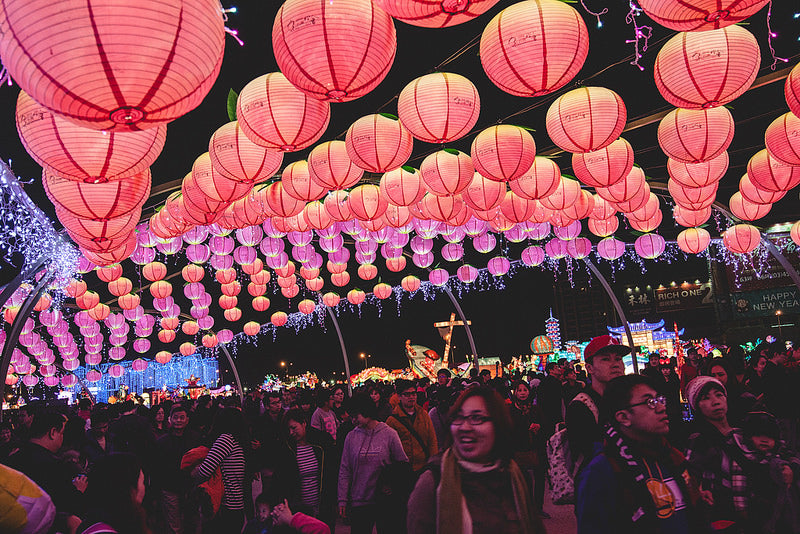
The Lantern Festival: A Beautiful End to Lunar New Year
It’s been a fun and festive two weeks of Lunar New Year celebrations, but like all good things, they must come to an end. Luckily they end with the Lantern Festival.
Celebrated on the last day of the 15-day Spring Festival — Feb. 24 this year — this effulgent fete involves dancing, eating, and of course lots of lanterns.
Where it comes from
As with many Chinese holidays, the Lantern Festival has many origin stories, but the most popular one traces it back more than 2,000 years to the Han Dynasty. An emperor (Wen or Ming, depending on the source) who was a proponent of Buddhism noticed Buddhist monks lighting lanterns on the 15th day of the first lunar month of the year. He liked what he saw, and ordered everyone to do the same.
What the lanterns mean
Depending on who you ask, the lanterns might laud shorter nights and longer days or the invention of man-made lights. They might also represent hopes and wishes rising to the sky while their round shape could symbolize the completeness of family.
Whatever they mean, preparations begin on the 13th day of the first lunar month when the lanterns are brought out. They’re tested the next day and formally lit the day after, on the 15th. They’re left up for three days and taken down on the 18th.
Lantern riddles
For extra fun, sometimes riddles are written on the lanterns. This custom might have started during the Tang Dynasty, which ruled during parts of the seventh, eighth, and 10th centuries. These riddles were said to be extremely difficult, hence their nicknames of "literary tiger" and "lantern tiger." If you managed to solve one, you could say you shot the literary tiger.
While classic riddles refer to Chinese idioms, literature, historical figures, and places in China, modern ones are about more everyday topics. A few of our favorite examples include:
- This lovely maiden eats leaves and no meat. She spins and weaves all day. Who is she?
- What's something that belongs to you but which others use more?
- It counts numbers all day and night but never gets past 12. What is it?
If you guessed a silkworm, your name, and a clock, respectively, you were right.
What to eat
The Lunar New Year season begins and ends on a symbol of completeness. Sticky rice balls called tangyuan are eaten during both the Dongzhi Festival, a winter solstice holiday that's a kind of Spring Festival sneak preview, and the Lantern Festival, the closing celebration.
Literally “soup balls,” tangyuan are also called yuanxiao, or “lanterns,” due to their resemblance to the round lights. They can be sweet or savory. Sweet fillings include sesame, bean, or jujube paste, walnuts, some flowers, and candied tangerine peel. Savory varieties include meat and vegetables.
The tangyuan’s round shape symbolizes perfection, unity, and family togetherness. A Taiwanese idiom says, “Eating tangyuan leads to reunions.”
Dancing in the street (and elsewhere)
In addition to lion and dragon dances, you might also see traditional folk dancing called Yangge or Yangko during the Lantern Festival. It usually involves large groups of colorfully decked out performers, and hails from northern China with different regions giving the dance their own flavor.
North Shaanxi. Call them the Pied Piper of Yangge dancing. In groups they move throughout different parts of towns lead by a kind of drum major, only instead of a wand or baton, they hold an umbrella, hence the leader’s name, santou, “umbrella head.”
The santou leads the group in an improvised song, first in single file, then a large circle, then more complex patterns. In addition to the leader and brightly hued dancers, you might also see see a Big-Headed Monk, a common comic character in Chinese processions, and the Eight Immortals, magical beings from Chinese myth.
Shandong. Within this province, there are two regional varieties of Yangge, Haiyang and Jiaozhou. A third kind is called Guzi Yangge, where guzi means “drum” and refers to one of the five roles the dancers take. The others are umbrella, stick, flower, and clown.
Dongbei. Not surprisingly, parts of the northeast region of China, once known as Manchuria, shows Manchu influence through the performers' clothing. As for the dance, it's free-flowing and brisk, and is supposed to imitate their ancestors who exceled in horse riding and archery.
Liaoning. Popular in this northeast province, as well as nearby Beijing, is Yangge on stilts. Within this type are many variations, including Jietang, dancing in the street; Dachang, dancing in wide, open spaces; Jiaxiang, involving the formation of pyramids; and Xiaochang, which incorporates a love story.
Want to learn more about Chinese holidays? Check out our posts on the Mid-Autumn Festival, the Hungry Ghost Festival, and the Dragon Boat Festival. If you're in the New York area, be sure to check out the Light Up Chinatown lantern installation throughout Manhattan's Chinatown.
[Image via Flickr: "Taoyuan Lantern Festival" by Jirka Matousek, CC BY 2.0]
